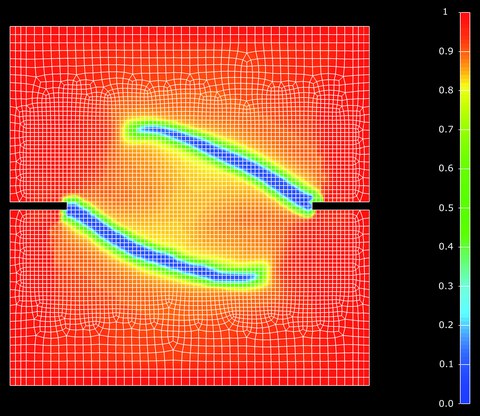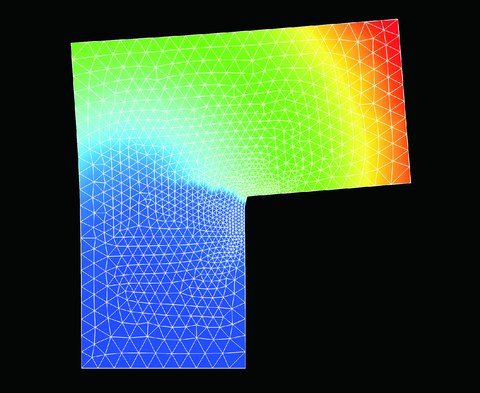Multi-axial constitutive laws based on anisotropic damage and ductility
Table of contents
Project data
| Titel | Title Mehraxiale Stoffgesetze für Beton auf der Grundlage anisotroper Schädigung und Plastizität | Multi-axial constitutive laws based on anisotropic damage and plasticity Förderer | Funding Deutsche Forschungsgemeinschaft (DFG) Zeitraum | Period 05/2007 – 04.2011 Leiter | Project manager Prof. Dr.-Ing. habil. Ulrich Häußler-Combe Bearbeiter | Contributor Dipl.-Ing. Mirko Kitzig |
Report in the yearbook 2010
Multi-axial damage constitutive laws for concrete

Calculated damage path in the notched specimens
Despite several decades of research in the field of constitutive modelling of concrete subject to general loading, most of the suggested formulations are either only applicable to problems with specific geometrical and loading configurations or due to their complexity hardly comprehensible for users of finite element software. The current research project aims to contribute to the realistic simulation of structures utilized in engineering practice by means of numerical methods.
The simulation of such structures - to prevent unacceptable calculation times – still requires the macroscopic level. This entails the necessity for homogenisation of the distinctive heterogeneous material concrete. Therefore mainly phenomenological damage approaches within the framework of continuum mechanics are formulated in the current project. The observable macroscopic elastic properties of the material and their evolution as a result of initiation, growth and coalescence of defects at the micro level are characterized by means of appropriate damage variables.
Concrete exhibits distinct softening characteristics under compressive as well as under tensile loading, i.e. after reaching a maximum value – the strength - at a material point the stresses decrease again with increasing strains. If such softening constitutive laws are implemented in numerical methods such as FEM, the calculated system responses initially highly depend on the used element size and orientation. Therefore, so-called regularisation methods have to be included.
Within the current project constitutive models are formulated, which take into account a directional dependency of the material behaviour. This property which is characteristic for concrete results from a preferred orientation of impressed cracks as a result of external loading. Mesh dependence of numerical results is resolved by non-local methods, which take into account the influence of adjacent regions on the material characteristic for the point under consideration. In this way, the damage variable will be averaged out of the portion of several elements and objective results are obtained. In the simulation of common tests of plain concrete specimens both load-displacement relationships and observed crack paths can be accurately reproduced using the developed approaches.
Report in the yearbook 2009
Multi-axial concrete constitutive laws

Simulated deformation of a concrete slab
The realistic simulation of engineered structural concrete members subjected to general loading requires the accurate description of complex, multi-axial material behavior based on constitutive laws. This research aims to contribute to the characterization of structures, utilized in practice, by means of numerical simulation methods.
Macroscopic level analysis was selected for purposes of this study since constitutive laws for concrete, as a homogenized material, are founded within the framework of continuum mechanics. Damage and plasticity approaches were, therefore, combined and applied. Damage mechanics is used to describe the degradation of macroscopically observable elastic material properties that results from the initiation and development of micro-defects. Plastic deformations are included to represent typical concrete characteristics present under pronounced compressive loading.
In numerical simulation methods, such as the Finite Element Method (FEM), the integration of material law with strain softening leads to a significant mesh-dependency of results. For this reason, regularization procedures must be adopted. These procedures are either local formulations based on fracture energy or, alternatively, nonlocal approaches that account for the influence on the material state of regions adjacent to the point under consideration.
A reference material model was developed based on the above mentioned methods under the assumption of isotropic material properties, i. e., material properties are independent of direction. Simulations of well-known tests using this constitutive law have led to satisfactory correspondence between numerical and experimental results with respect to, for instance, the load-displacement relationship. Crack paths observed during testing were not precisely reproduced, however, and the reference model was, therefore, extended to include formulations that account for the directional dependence of material behavior related to crack formation as a result of external loads. Consequently, crack paths were also correctly captured with respect to their orientation.
Fracture-energy based regularization procedures were observed to be easily implemented into numerical methods. The width of the localization zone used in calculation must, however, be predefined as priori. This drawback can be eliminated by using enhanced non-local procedures, admittedly, at the expense of increased effort for implementation and simulation/calculation time.
